A Systematic Compact Model Parameter Calibration with Adaptive Pattern Search Algorithm
Abstract
1. Introduction
2. Problem Definition
3. Configuration of the Experiment
4. Pattern Search Algorithm
5. Results
5.1. Adaptive Pattern Search
5.1.1. Adaptive Pattern Move
5.1.2. Parallel Exploration
5.2. Curve Fitting Result
6. Discussion
Author Contributions
Funding
Institutional Review Board Statement
Informed Consent Statement
Data Availability Statement
Conflicts of Interest
References
- Levenberg, K. A method for the solution of certain non-linear problems in least squares. Q. Appl. Math. 1944, 2, 164–168. [Google Scholar] [CrossRef]
- Marquardt, D.W. An Algorithm for Least-Squares Estimation of Nonlinear Parameters. J. Soc. Ind. Appl. Math. 1963, 11, 431–441. [Google Scholar] [CrossRef]
- Singh, K.; Jain, P. BSIM3v3 to EKV2.6 Model Parameter Extraction and Optimisation Using LM Algorithm on 0.18 Micron Technology Node. Int. J. Electon. Telecommun. 2018, 64, 5–11. [Google Scholar]
- Goldberg, D.E. Genetic Algorithms in Search, Optimization and Machine Learning, 13th ed.; Addison-Wesley Professional: Reading, MA, USA, 1988; ISBN 978-0-201-15767-3. [Google Scholar]
- Karr, C.; Weck, B.; Massart, D.; Vankeerberghen, P. Least median squares curve fitting using a genetic algorithm. Eng. Appl. Artif. Intell. 1995, 8, 177–189. [Google Scholar] [CrossRef]
- Fogel, D.B. Evolutionary Computation: The Fossil Record, 1st ed.; Wiley-IEEE Press: New York, NY, USA, 1998; ISBN 978-0-7803-3481-6. [Google Scholar]
- Jervase, J.A.; Bourdoucen, H.; Al-Lawati, A. Solar cell parameter extraction using genetic algorithms. Meas. Sci. Technol. 2001, 12, 1922–1925. [Google Scholar] [CrossRef]
- Spałek, T.; Pietrzyk, P.; Sojka, Z. Application of the Genetic Algorithm Joint with the Powell Method to Nonlinear Least-Squares Fitting of Powder EPR Spectra. J. Chem. Inf. Model. 2005, 45, 18–29. [Google Scholar] [CrossRef] [PubMed]
- Li, Y. An automatic parameter extraction technique for advanced CMOS device modeling using genetic algorithm. Microelectron. Eng. 2007, 84, 260–272. [Google Scholar] [CrossRef]
- Hooke, R.; Jeeves, T.A. “Direct Search’’ Solution of Numerical and Statistical Problems. J. ACM 1961, 8, 212–229. [Google Scholar] [CrossRef]
- Torczon, V. On the Convergence of Pattern Search Algorithms. SIAM J. Optim. 1997, 7, 1–25. [Google Scholar] [CrossRef]
- Ayala-Mató, F.; Seuret-Jiménez, D.; Escobedo-Alatorre, J.J.; Vigil-Galán, O.; Courel, M. A hybrid method for solar cell parameter estimation. J. Renew. Sustain. Energy 2017, 9, 063504. [Google Scholar] [CrossRef]
- Parke, S.; Moon, J.; Wann, H.; Ko, P.; Hu, C. Design for suppression of gate-induced drain leakage in LDD MOSFETs using a quasi-two-dimensional analytical model. IEEE Trans. Electron Devices 1992, 39, 1694–1703. [Google Scholar] [CrossRef]
- Liu, Z.H.; Hu, C.; Huang, J.H.; Chan, T.Y.; Jeng, M.C.; Ko, P.; Cheng, Y. Threshold voltage model for deep-submicrometer MOSFETs. IEEE Trans. Electron Devices 1993, 40, 86–95. [Google Scholar] [CrossRef]
- Hu, C. BSIM4.8.1 MOSFET MODEL Users Manual; UC Berkeley: Berkeley, CA, USA, 2017. [Google Scholar]
- Cheng, Y.; Hu, C. MOSFET Modeling & BSIM3 User’s Guide; Springer: New York, NY, USA, 2002; ISBN 978-0-7923-8575-2. [Google Scholar]
- Venugopalan, S.; Lu, D.D.; Kawakami, Y.; Lee, P.M.; Niknejad, A.M.; Hu, C. BSIM-CG: A compact model of cylindrical/surround gate MOSFET for circuit simulations. Solid State Electron. 2012, 67, 79–89. [Google Scholar] [CrossRef]
- Khandelwal, S.; Duarte, J.P.; Chauhan, Y.S.; Hu, C. Modeling 20-nm Germanium FinFET With the Industry Standard FinFET Model. IEEE Electron Device Lett. 2014, 35, 711–713. [Google Scholar] [CrossRef]
- Enz, C.C.; Vittoz, E.A. An analytical MOS transistor model valid in all regions of operation and dedicated to low-voltage and low-current applications. Analog. Integr. Circuits Signal Process. 1995, 8, 83–114. [Google Scholar] [CrossRef]
- Gildenblat, G.; Li, X.; Wu, W.; Wang, H.; Jha, A.; Van Langevelde, R.; Smit, G.; Scholten, A.; Klaassen, D. PSP: An Advanced Surface-Potential-Based MOSFET Model for Circuit Simulation. IEEE Trans. Electron Devices 2006, 53, 1979–1993. [Google Scholar] [CrossRef]
- Li, X.; Wu, W.; Jha, A.; Gildenblat, G.; Van Langevelde, R.; Smit, G.D.; Scholten, A.J.; Klaassen, D.B.; McAndrew, C.C.; Watts, J.; et al. Benchmarking the PSP Compact Model for MOS Transistors. In Proceedings of the 2007 IEEE International Conference on Microelectronic Test Structures, Bunkyo-ku, Japan, 19–22 March 2007; Institute of Electrical and Electronics Engineers (IEEE): Piscataway, NJ, USA, 2007; pp. 259–264. [Google Scholar]
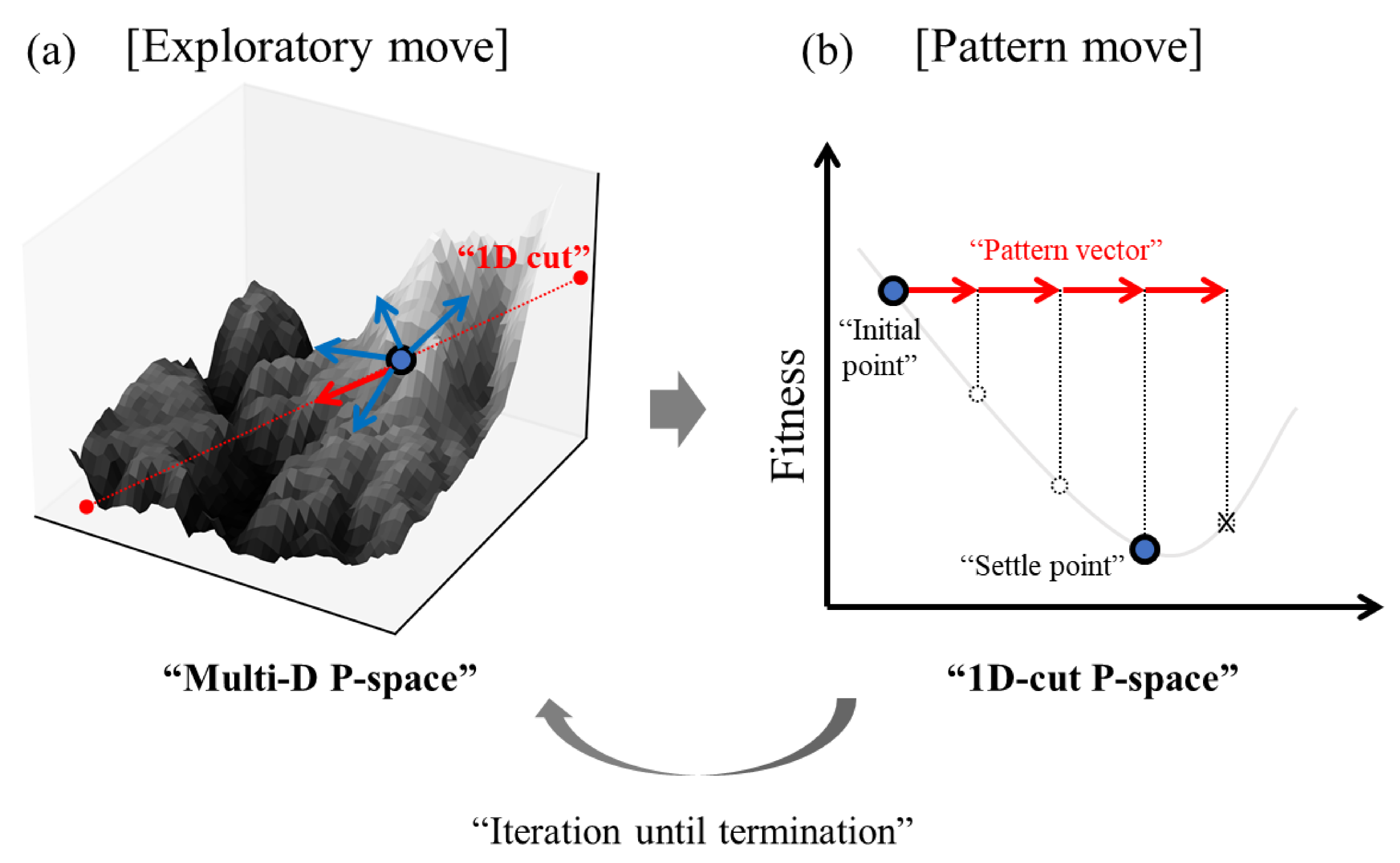
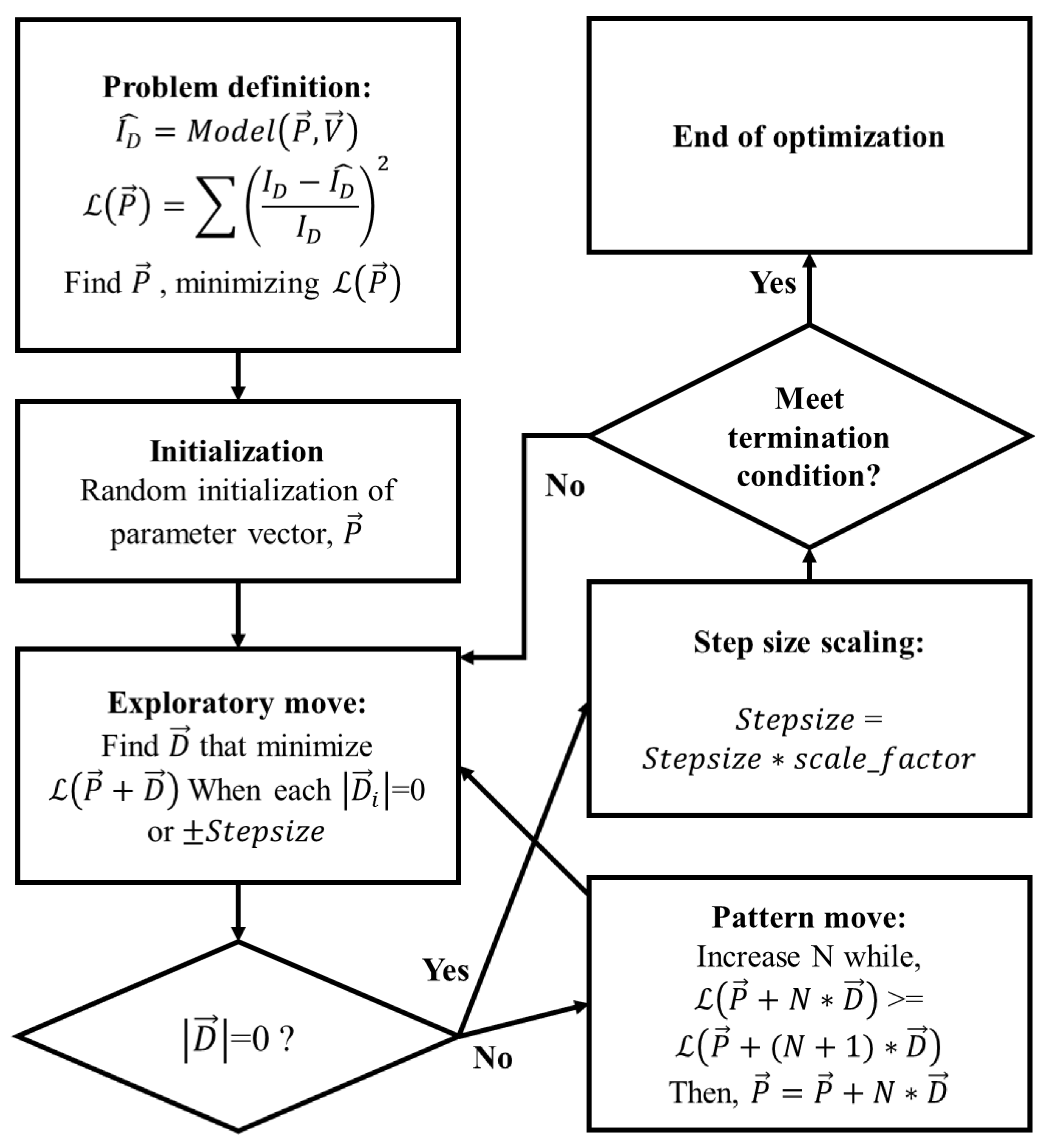
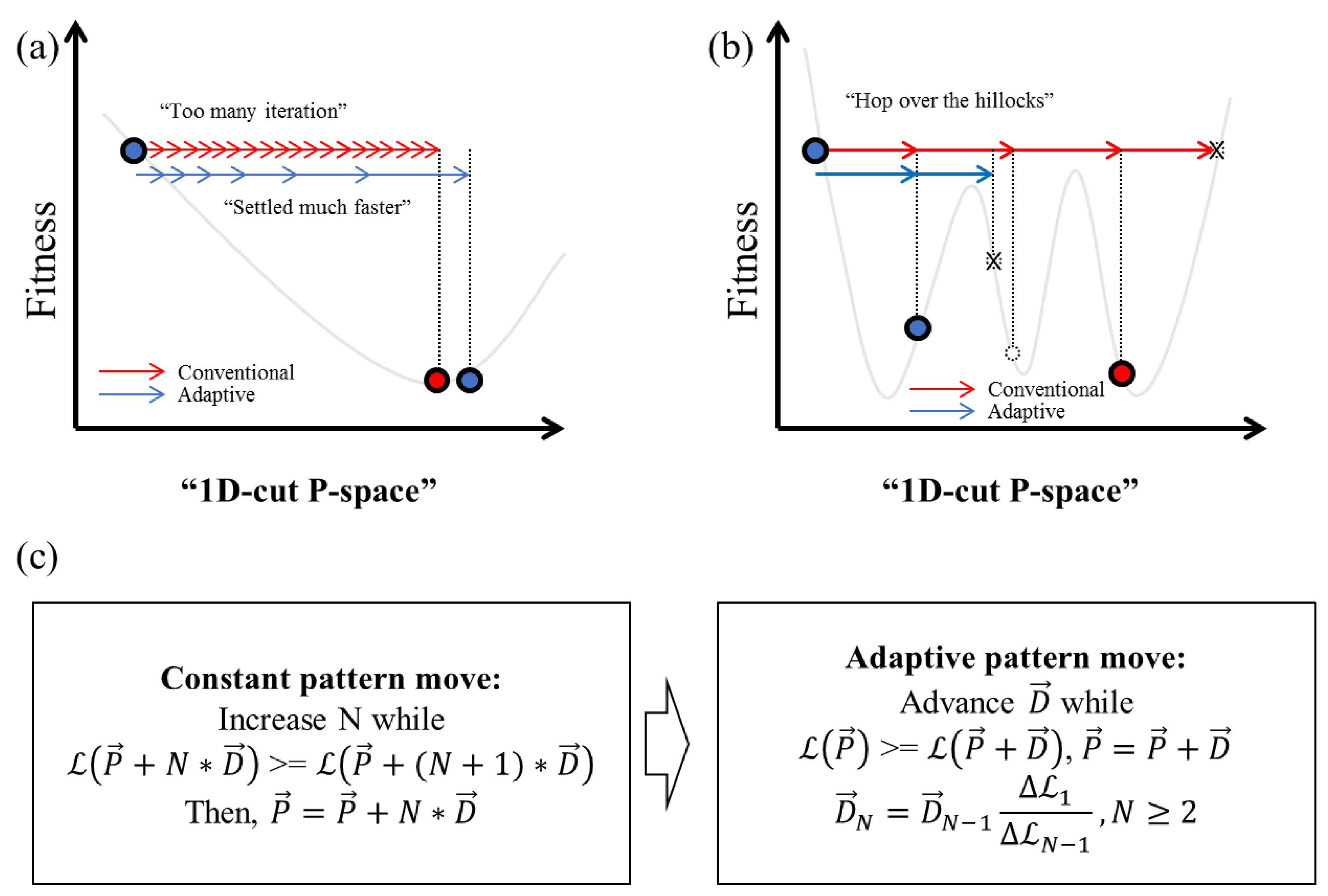


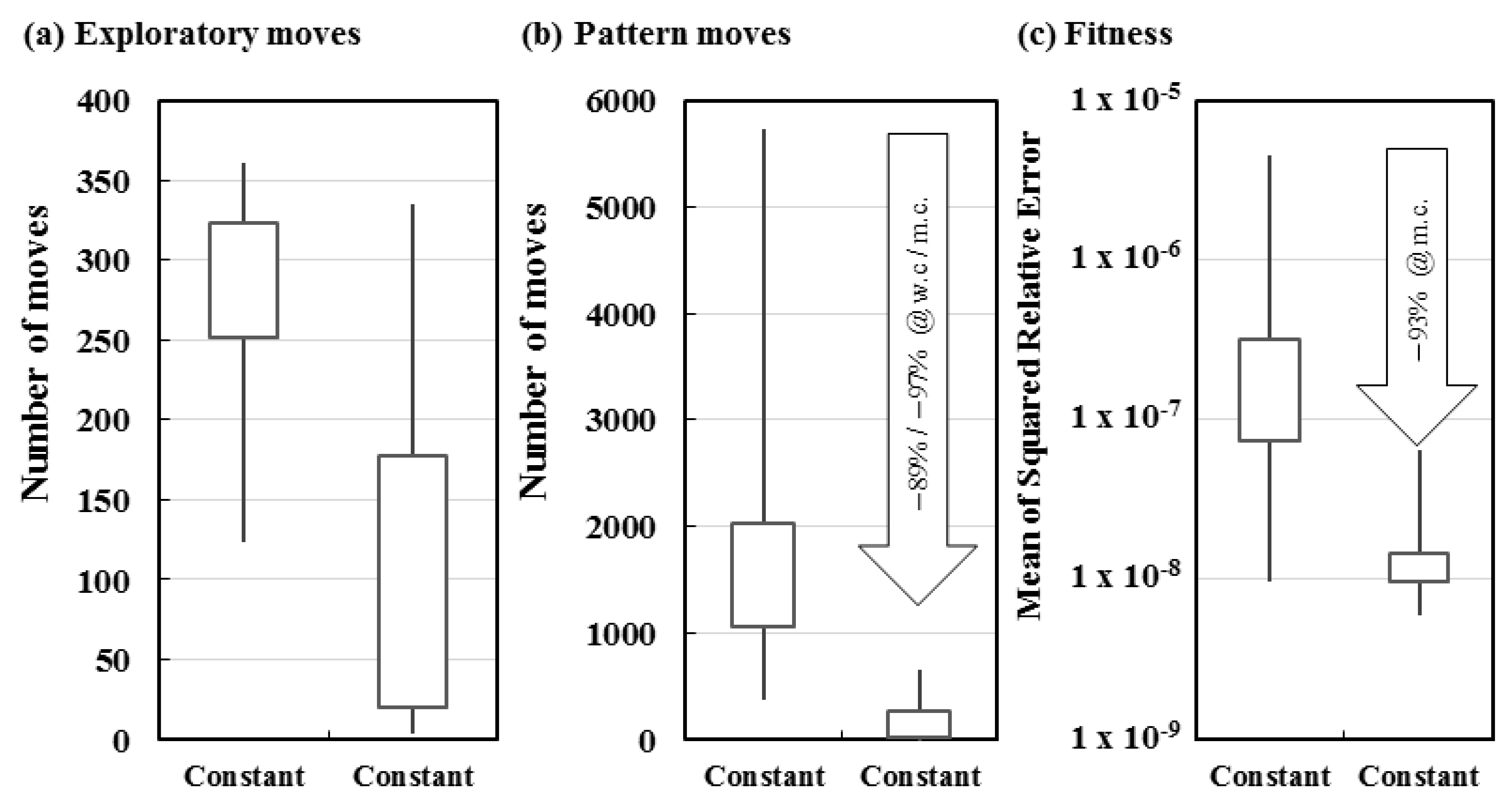

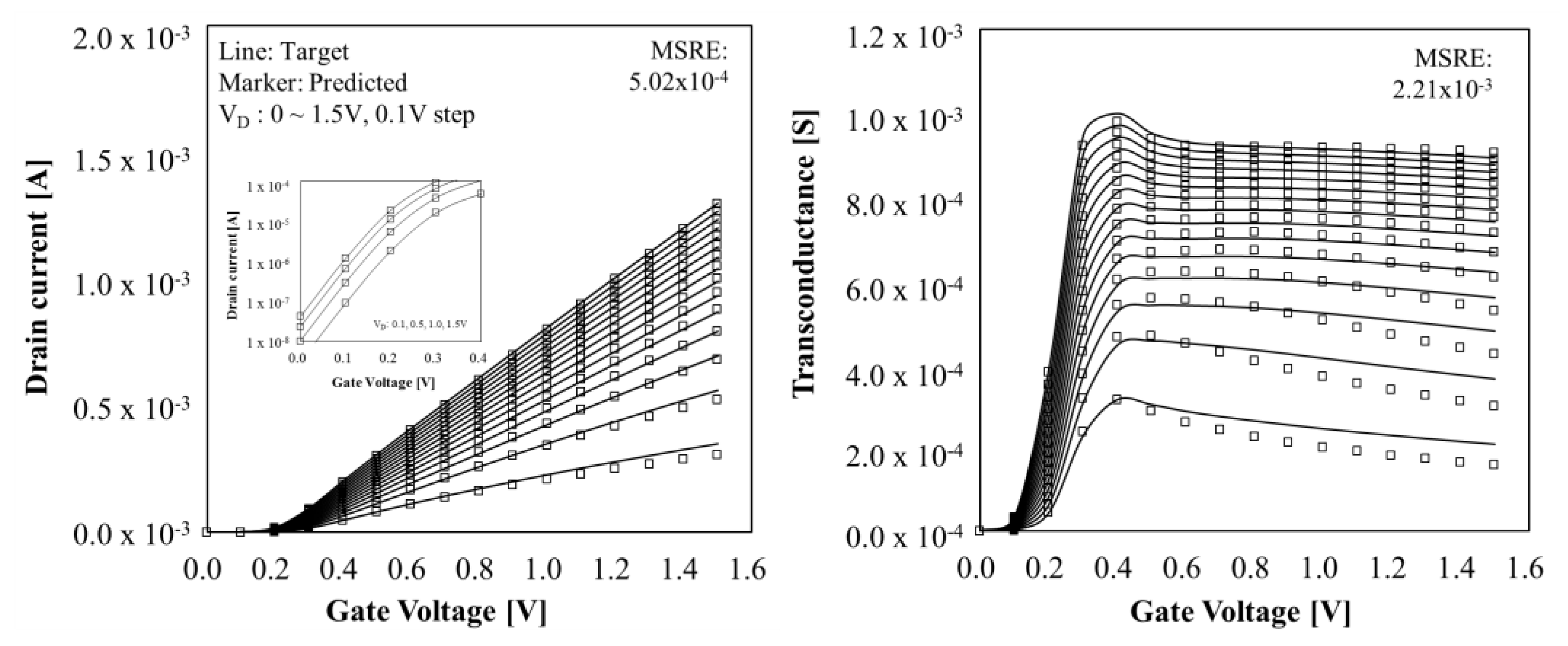
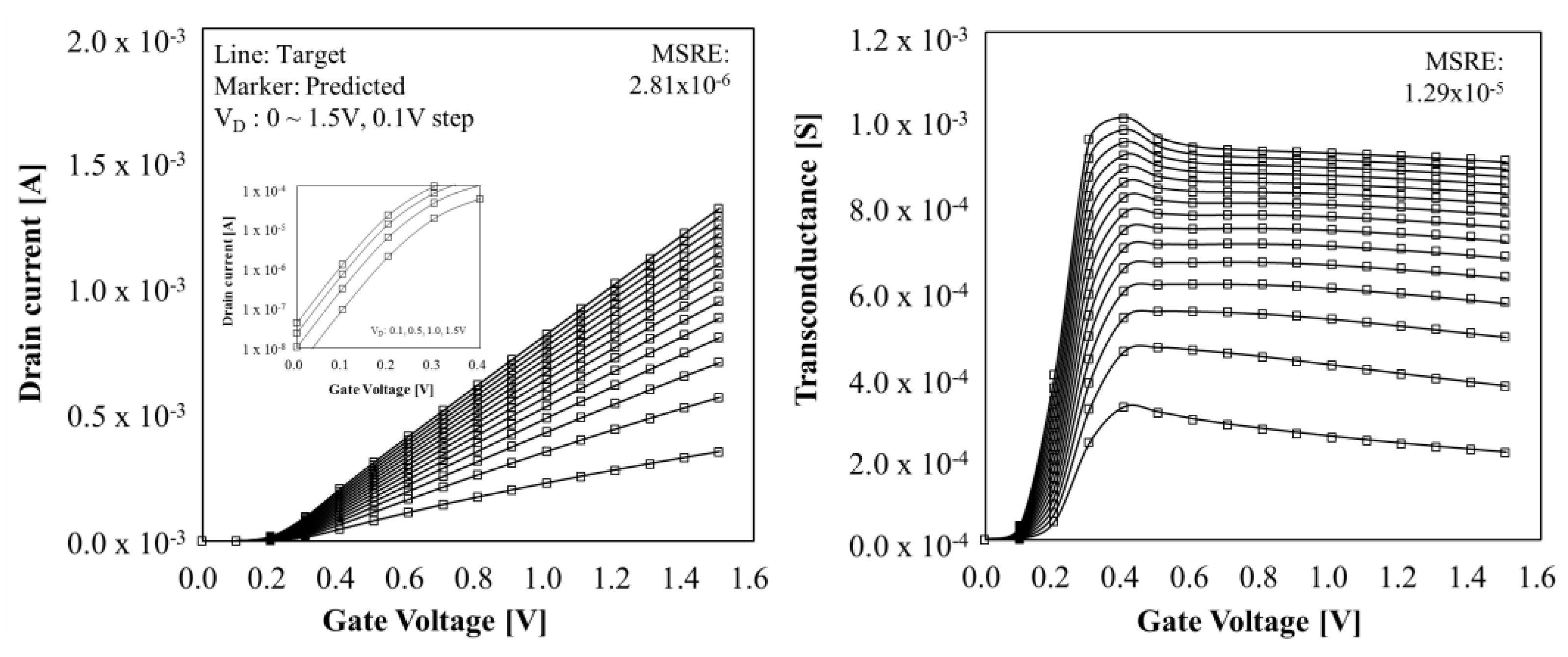
| Parameter | Lower Bound (ΔID) | Upper Bound (ΔID) |
|---|---|---|
| DELVTO | −6.25 × 10−2 (+10%) | 5.468 × 10−2 (−10%) |
| U0 | 5.39 × 10−2 (−10%) | 9.109 × 10−2 (+10%) |
| VSAT | 6.562 × 10+4 (−10%) | 9.812 × 10+4 (+10%) |
| RDSW | 6.25 × 10+1 (+10%) | 3.593 × 10+2 (−10%) |
| DVT0 | 0.0 (−8%) | 5.2 (+10%) |
| ETA0 | 0.0 (−5%) | 5.1 × 10−1 (+10%) |
| UA | 1.0 × 10−10 (+8%) | 2.2 × 10−9 (−10%) |
| PCLM | 6.3 × 10−1 (−10%) | 2.25 (+10%) |
| XJ | 8.3 × 10−8 (+10%) | 4.43 × 10−7 (−5%) |
| NSUB | 6.0 × 1016 (−10%) | 1.0 × 1017 (+10%) |
Publisher’s Note: MDPI stays neutral with regard to jurisdictional claims in published maps and institutional affiliations. |
© 2021 by the authors. Licensee MDPI, Basel, Switzerland. This article is an open access article distributed under the terms and conditions of the Creative Commons Attribution (CC BY) license (https://creativecommons.org/licenses/by/4.0/).
Share and Cite
Chang, J.; Hwang, S.; Park, K.; Jang, T.; Min, K.-K.; Oh, M.-H.; Park, J.; Lee, J.-H.; Park, B.-G. A Systematic Compact Model Parameter Calibration with Adaptive Pattern Search Algorithm. Appl. Sci. 2021, 11, 4155. https://doi.org/10.3390/app11094155
Chang J, Hwang S, Park K, Jang T, Min K-K, Oh M-H, Park J, Lee J-H, Park B-G. A Systematic Compact Model Parameter Calibration with Adaptive Pattern Search Algorithm. Applied Sciences. 2021; 11(9):4155. https://doi.org/10.3390/app11094155
Chicago/Turabian StyleChang, Jeesoo, Sungmin Hwang, Kyungchul Park, Taejin Jang, Kyung-Kyu Min, Min-Hye Oh, Jonghyuk Park, Jong-Ho Lee, and Byung-Gook Park. 2021. "A Systematic Compact Model Parameter Calibration with Adaptive Pattern Search Algorithm" Applied Sciences 11, no. 9: 4155. https://doi.org/10.3390/app11094155
APA StyleChang, J., Hwang, S., Park, K., Jang, T., Min, K.-K., Oh, M.-H., Park, J., Lee, J.-H., & Park, B.-G. (2021). A Systematic Compact Model Parameter Calibration with Adaptive Pattern Search Algorithm. Applied Sciences, 11(9), 4155. https://doi.org/10.3390/app11094155






